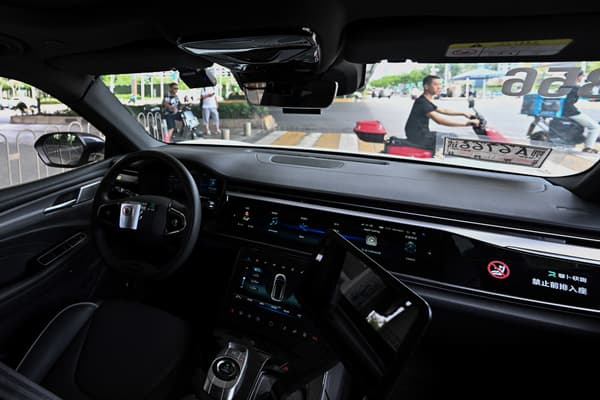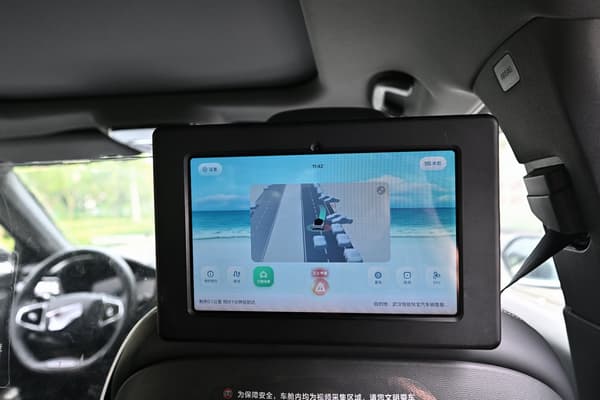“Like something out of a science fiction movie!”: Driverless taxis are spreading across China’s cities, where they are causing people to stare in awe, but also arousing enthusiasm and distrust.
Chinese tech giants and carmakers have invested billions of euros in autonomous driving in recent years, hoping to catch up with American leaders.
500 driverless taxis in Wuhan
The sprawling city of Wuhan, home to 14 million people in central China, has become the world’s largest laboratory for the industry: 500 driverless taxis, or “robotaxis,” are in operation there. A world record.
They can be requested with a simple mobile application, just like a normal race.
“It’s a bit magical, like something out of a science fiction movie!” Mr Yang, a Wuhan resident, told AFP.
However, not everyone shares his enthusiasm.
Fears about the technology’s safety were revived in April when an Aito vehicle from electronics manufacturer Huawei was involved in a fatal accident in China. The company said the automatic braking system had not been activated.

A collision, fortunately not serious, between a pedestrian and a robotaxi in Wuhan last month has rekindled concerns.
For their part, drivers of traditional taxis and VTC (car transport with driver) fear being gradually displaced by this technology.
Wuhan’s robotaxis are part of Chinese tech giant Baidu’s “Apollo Go” project, which received a first license to operate in the city in 2022.
“They are stealing our livelihood,” curses a taxi driver
Its fleet is currently deployed over 3,000 square kilometres, more than a third of the city’s surface area.
By comparison, US leader Waymo says the largest area it covers is 816 square kilometres in Arizona.
When a car arrives at the boarding point, passengers must scan a QR code with their phone to unlock the vehicle.
Prices are deliberately reduced: a 30-minute trip with the AFP will cost just 39 yuan (4.95 euros), compared to 64 yuan (8.13 euros) if it were made with a normal taxi.
“They are stealing our livelihood,” complains Deng Haibing, a taxi driver in Wuhan.

Their fear: that robotaxi companies will crush the competition with their low prices, before raising them again once they are in a favorable situation. A tactic already used by Chinese ride-hailing companies in the 2010s.
However, robotaxis currently make up only a small proportion of the tens of thousands of taxis and VTCs in Wuhan.
But a growing number of Chinese cities have launched policies that favor autonomous driving, a trend encouraged by the government to rival the United States.
Baidu and its Chinese rival Pony.ai have been testing various models with different levels of autonomy for years, often in industrial areas that are less busy than urban centres.
Remote monitoring by agents
In July, Shanghai issued the first provisional permits for the use of driverless cars. Beijing has approved the use of fully autonomous robotaxis in some peripheral areas.
German manufacturer Mercedes-Benz, at the forefront in this field, has just obtained authorization to carry out level 4 autonomous driving tests, which allow people to take their hands off the wheel, on urban roads and highways in the Chinese capital.
Pilot projects led by other brands are also underway in Chongqing and Shenzhen, China’s technology capital.

But there is still a long way to go before such vehicles become ubiquitous, according to Tom Nunlist, an analyst at Beijing-based firm Trivium China.
“Today everyone seems to think that autonomous driving is inevitable,” he told AFP.
But “for the moment, this technology (…) is simply not ready for large-scale deployment,” he stressed.
Because although Apollo Go taxis in Wuhan can detect obstacles and are very careful at intersections, the journeys are still monitored remotely by in-person agents.
During one trip, one of them contacted AFP journalists via the passenger compartment’s touch screen to remind them to fasten their seat belts.
However, robotaxis will never be able to replace humans in certain aspects.
“Some customers have disabilities and these self-driving cars can’t help them. Not to mention passengers with bulky items,” said Mr Zhao, a ride-hailing driver.
“Only a human can lend a hand.”
Source: BFM TV

